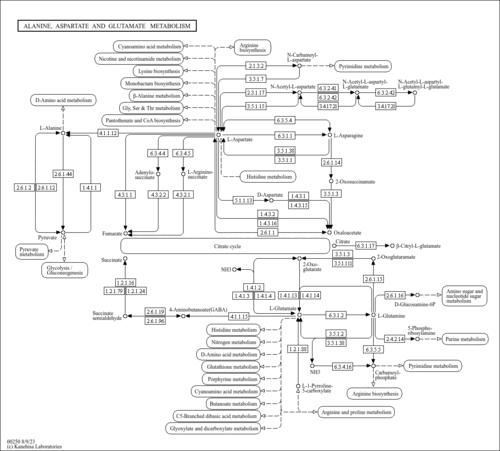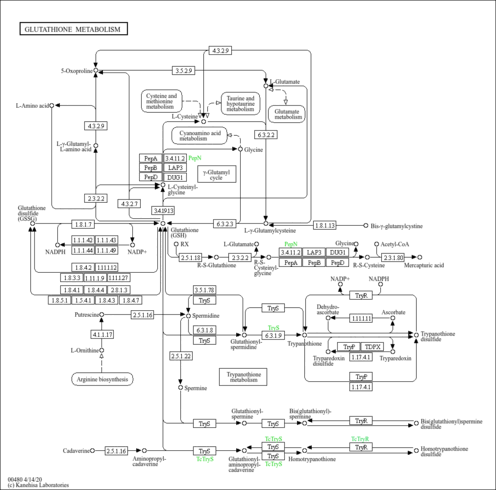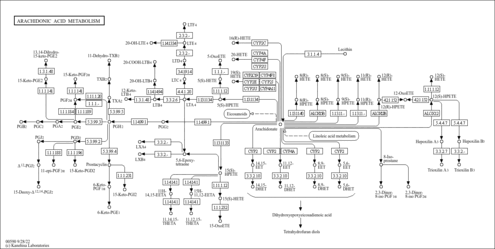| Record Information |
|---|
| Version | 1.0 |
|---|
| Created at | 2020-04-17 18:38:34 UTC |
|---|
| Updated at | 2020-12-07 19:10:59 UTC |
|---|
| CannabisDB ID | CDB004805 |
|---|
| Secondary Accession Numbers | Not Available |
|---|
| Cannabis Compound Identification |
|---|
| Common Name | Glutathione |
|---|
| Description | Glutathione, also known as GSH or agifutol S, belongs to the class of organic compounds known as peptides. Peptides are compounds containing an amide derived from two or more amino carboxylic acid molecules (the same or different) by formation of a covalent bond from the carbonyl carbon of one to the nitrogen atom of another. Glutathione is a drug which is used for nutritional supplementation, also for treating dietary shortage or imbalance. Glutathione is a very strong basic compound (based on its pKa). A tripeptide compound consisting of glutamic acid attached via its side chain to the N-terminus of cysteinylglycine. Glutathione exists in all living species, ranging from bacteria to humans. Within humans, glutathione participates in a number of enzymatic reactions. In particular, leukotriene A4 and glutathione can be converted into leukotriene C4 through its interaction with the enzyme leukotriene C4 synthase. In addition, 15(S)-hpete and glutathione can be converted into 15(S)-hete and oxidized glutathione through its interaction with the enzyme glutathione peroxidase 1. In humans, glutathione is involved in mefenamic acid action pathway. Outside of the human body, Glutathione is found, on average, in the highest concentration within a few different foods, such as purslanes, spinachs, and corns. Glutathione has also been detected, but not quantified in, several different foods, such as yautia, coconuts, common salsifies, pigeon pea, and ohelo berries. This could make glutathione a potential biomarker for the consumption of these foods. Glutathione is a potentially toxic compound. Glutathione is expected to be in Cannabis as all living plants are known to produce and metabolize it. |
|---|
| Structure | |
|---|
| Synonyms | | Value | Source |
|---|
| 5-L-Glutamyl-L-cysteinylglycine | ChEBI | | gamma-L-Glutamyl-L-cysteinyl-glycine | ChEBI | | Glutathione-SH | ChEBI | | GSH | ChEBI | | N-(N-gamma-L-Glutamyl-L-cysteinyl)glycine | ChEBI | | Reduced glutathione | ChEBI | | Poly(gamma-glutamylcysteine)glycine | Kegg | | (gamma-Glutamylcysteine)N-glycine | Kegg | | Tathion | Kegg | | g-L-Glutamyl-L-cysteinyl-glycine | Generator | | Γ-L-glutamyl-L-cysteinyl-glycine | Generator | | N-(N-g-L-Glutamyl-L-cysteinyl)glycine | Generator | | N-(N-Γ-L-glutamyl-L-cysteinyl)glycine | Generator | | Poly(g-glutamylcysteine)glycine | Generator | | Poly(γ-glutamylcysteine)glycine | Generator | | (g-Glutamylcysteine)N-glycine | Generator | | (Γ-glutamylcysteine)N-glycine | Generator | | Agifutol S | HMDB | | Bakezyme RX | HMDB | | Copren | HMDB | | Deltathione | HMDB | | gamma-Glutamylcysteinylglycine | HMDB | | gamma-L-Glutamyl-L-cysteinylglycine | HMDB | | Glutathion | HMDB | | Glutathione red | HMDB | | Glutathione reduced | HMDB | | Glutatiol | HMDB | | Glutatione | HMDB | | Glutide | HMDB | | Glutinal | HMDB | | Isethion | HMDB | | L-g-Glutamyl-L-cysteinyl-glycine | HMDB | | L-gamma-Glutamyl-L-cysteinyl-glycine | HMDB | | L-gamma-Glutamyl-L-cysteinylglycine | HMDB | | L-Glutamyl-L-cysteinylglycine | HMDB | | L-Glutathione | HMDB | | L-Glutathione reduce | HMDB | | Ledac | HMDB | | Neuthion | HMDB | | Red. glutathione | HMDB | | Tathione | HMDB | | Triptide | HMDB | | Glutathione, reduced | HMDB | | gamma L Glu L cys gly | HMDB | | gamma-L-Glu-L-cys-gly | HMDB | | gamma L Glutamyl L cysteinylglycine | HMDB |
|
|---|
| Chemical Formula | C10H17N3O6S |
|---|
| Average Molecular Weight | 307.32 |
|---|
| Monoisotopic Molecular Weight | 307.0838 |
|---|
| IUPAC Name | (2S)-2-amino-4-{[(1R)-1-[(carboxymethyl)carbamoyl]-2-sulfanylethyl]carbamoyl}butanoic acid |
|---|
| Traditional Name | glutathione |
|---|
| CAS Registry Number | 70-18-8 |
|---|
| SMILES | N[C@@H](CCC(=O)N[C@@H](CS)C(=O)NCC(O)=O)C(O)=O |
|---|
| InChI Identifier | InChI=1S/C10H17N3O6S/c11-5(10(18)19)1-2-7(14)13-6(4-20)9(17)12-3-8(15)16/h5-6,20H,1-4,11H2,(H,12,17)(H,13,14)(H,15,16)(H,18,19)/t5-,6-/m0/s1 |
|---|
| InChI Key | RWSXRVCMGQZWBV-WDSKDSINSA-N |
|---|
| Chemical Taxonomy |
|---|
| Description | Belongs to the class of organic compounds known as peptides. Peptides are compounds containing an amide derived from two or more amino carboxylic acid molecules (the same or different) by formation of a covalent bond from the carbonyl carbon of one to the nitrogen atom of another. |
|---|
| Kingdom | Organic compounds |
|---|
| Super Class | Organic acids and derivatives |
|---|
| Class | Carboxylic acids and derivatives |
|---|
| Sub Class | Amino acids, peptides, and analogues |
|---|
| Direct Parent | Peptides |
|---|
| Alternative Parents | |
|---|
| Substituents | - Alpha peptide
- N-acyl-alpha-amino acid
- N-acyl-alpha amino acid or derivatives
- Alpha-amino acid
- Alpha-amino acid or derivatives
- L-alpha-amino acid
- Dicarboxylic acid or derivatives
- Fatty acid
- Amino acid or derivatives
- Amino acid
- Alkylthiol
- Carboximidic acid
- Carboximidic acid derivative
- Carboxylic acid
- Organic 1,3-dipolar compound
- Propargyl-type 1,3-dipolar organic compound
- Hydrocarbon derivative
- Primary aliphatic amine
- Organic oxide
- Organic oxygen compound
- Organic nitrogen compound
- Carbonyl group
- Amine
- Organonitrogen compound
- Organooxygen compound
- Organosulfur compound
- Organopnictogen compound
- Primary amine
- Aliphatic acyclic compound
|
|---|
| Molecular Framework | Aliphatic acyclic compounds |
|---|
| External Descriptors | |
|---|
| Ontology |
|---|
|
| Physiological effect | Health effect: |
|---|
| Disposition | Route of exposure: Source: Biological location: |
|---|
| Role | Industrial application: Biological role: |
|---|
| Physical Properties |
|---|
| State | Solid |
|---|
| Experimental Properties | | Property | Value | Reference |
|---|
| Melting Point | 195 °C | Not Available | | Boiling Point | Not Available | Not Available | | Water Solubility | 292.5 mg/mL | Not Available | | logP | Not Available | Not Available |
|
|---|
| Predicted Properties | [] |
|---|
| Spectra |
|---|
| EI-MS/GC-MS | | Type | Description | Splash Key | View |
|---|
| GC-MS | Glutathione, x TMS, GC-MS Spectrum | splash10-0a4i-0900000000-5841845f736f9a667622 | Spectrum | | GC-MS | Glutathione, x TMS, GC-MS Spectrum | splash10-0a4i-0900000000-bdecde153761cb67852e | Spectrum | | GC-MS | Glutathione, non-derivatized, GC-MS Spectrum | splash10-0a4i-0900000000-5841845f736f9a667622 | Spectrum | | GC-MS | Glutathione, non-derivatized, GC-MS Spectrum | splash10-0a4i-0900000000-bdecde153761cb67852e | Spectrum | | GC-MS | Glutathione, non-derivatized, GC-MS Spectrum | splash10-0a4i-1910000000-52bc43dd913b68d74f84 | Spectrum | | GC-MS | Glutathione, non-derivatized, GC-MS Spectrum | splash10-08fs-3960000000-63ce34def2ae94b95515 | Spectrum | | GC-MS | Glutathione, non-derivatized, GC-MS Spectrum | splash10-0pb9-0921000000-88168b0a9f5fc5fead3f | Spectrum | | Predicted GC-MS | Glutathione, non-derivatized, Predicted GC-MS Spectrum - 70eV, Positive | splash10-0006-7890000000-5853006f66d946dd3d2e | Spectrum | | Predicted GC-MS | Glutathione, 2 TMS, Predicted GC-MS Spectrum - 70eV, Positive | splash10-0596-9112300000-e82cf72540c283d8e323 | Spectrum | | Predicted GC-MS | Glutathione, non-derivatized, Predicted GC-MS Spectrum - 70eV, Positive | Not Available | Spectrum | | Predicted GC-MS | Glutathione, TMS_1_1, Predicted GC-MS Spectrum - 70eV, Positive | Not Available | Spectrum | | Predicted GC-MS | Glutathione, TMS_1_2, Predicted GC-MS Spectrum - 70eV, Positive | Not Available | Spectrum | | Predicted GC-MS | Glutathione, TMS_1_3, Predicted GC-MS Spectrum - 70eV, Positive | Not Available | Spectrum | | Predicted GC-MS | Glutathione, TMS_1_4, Predicted GC-MS Spectrum - 70eV, Positive | Not Available | Spectrum | | Predicted GC-MS | Glutathione, TMS_1_5, Predicted GC-MS Spectrum - 70eV, Positive | Not Available | Spectrum | | Predicted GC-MS | Glutathione, TMS_1_6, Predicted GC-MS Spectrum - 70eV, Positive | Not Available | Spectrum | | Predicted GC-MS | Glutathione, TMS_2_2, Predicted GC-MS Spectrum - 70eV, Positive | Not Available | Spectrum | | Predicted GC-MS | Glutathione, TMS_2_3, Predicted GC-MS Spectrum - 70eV, Positive | Not Available | Spectrum | | Predicted GC-MS | Glutathione, TMS_2_4, Predicted GC-MS Spectrum - 70eV, Positive | Not Available | Spectrum | | Predicted GC-MS | Glutathione, TMS_2_5, Predicted GC-MS Spectrum - 70eV, Positive | Not Available | Spectrum | | Predicted GC-MS | Glutathione, TMS_2_6, Predicted GC-MS Spectrum - 70eV, Positive | Not Available | Spectrum | | Predicted GC-MS | Glutathione, TMS_2_7, Predicted GC-MS Spectrum - 70eV, Positive | Not Available | Spectrum | | Predicted GC-MS | Glutathione, TMS_2_8, Predicted GC-MS Spectrum - 70eV, Positive | Not Available | Spectrum | | Predicted GC-MS | Glutathione, TMS_2_9, Predicted GC-MS Spectrum - 70eV, Positive | Not Available | Spectrum | | Predicted GC-MS | Glutathione, TMS_2_10, Predicted GC-MS Spectrum - 70eV, Positive | Not Available | Spectrum |
|
|---|
| MS/MS | | Type | Description | Splash Key | View |
|---|
| MS/MS | LC-MS/MS Spectrum - Quattro_QQQ 10V, Positive (Annotated) | splash10-004i-3795000000-d019cd7dcbad1f8a9e78 | 2012-07-24 | View Spectrum | | MS/MS | LC-MS/MS Spectrum - Quattro_QQQ 25V, Positive (Annotated) | splash10-003r-9400000000-a83bf6292d41988256e3 | 2012-07-24 | View Spectrum | | MS/MS | LC-MS/MS Spectrum - Quattro_QQQ 40V, Positive (Annotated) | splash10-001i-9000000000-305a92f8a9ffea58fa0e | 2012-07-24 | View Spectrum | | MS/MS | LC-MS/MS Spectrum - LC-ESI-ITFT (LTQ Orbitrap XL, Thermo Scientfic) , Positive | splash10-0a4i-0009000000-e950bfc5867b391c6960 | 2012-08-31 | View Spectrum | | MS/MS | LC-MS/MS Spectrum - LC-ESI-ITFT (LTQ Orbitrap XL, Thermo Scientfic) , Positive | splash10-004i-0910000000-83f6c079d1112e74ecf4 | 2012-08-31 | View Spectrum | | MS/MS | LC-MS/MS Spectrum - LC-ESI-ITFT (LTQ Orbitrap XL, Thermo Scientfic) , Positive | splash10-003r-0910000000-5b243cf8bd357ab270b1 | 2012-08-31 | View Spectrum | | MS/MS | LC-MS/MS Spectrum - LC-ESI-ITFT (LTQ Orbitrap XL, Thermo Scientfic) , Positive | splash10-0a4i-0009000000-29ef335479f56b620d88 | 2012-08-31 | View Spectrum | | MS/MS | LC-MS/MS Spectrum - LC-ESI-ITFT (LTQ Orbitrap XL, Thermo Scientfic) , Positive | splash10-0a4i-0009001000-d1f5986166efa523d024 | 2012-08-31 | View Spectrum | | MS/MS | LC-MS/MS Spectrum - LC-ESI-ITFT (LTQ Orbitrap XL, Thermo Scientfic) , Positive | splash10-056s-0495300000-dba7be381fd1ef776527 | 2012-08-31 | View Spectrum | | MS/MS | LC-MS/MS Spectrum - LC-ESI-ITFT (LTQ Orbitrap XL, Thermo Scientfic) , Positive | splash10-004i-0920000000-de5b8a5a377324599b39 | 2012-08-31 | View Spectrum | | MS/MS | LC-MS/MS Spectrum - LC-ESI-ITFT (LTQ Orbitrap XL, Thermo Scientfic) , Positive | splash10-053r-0007920000-7500cef211e48c8ea244 | 2012-08-31 | View Spectrum | | MS/MS | LC-MS/MS Spectrum - LC-ESI-ITFT (LTQ Orbitrap XL, Thermo Scientfic) , Negative | splash10-0a4i-0119003000-4eb7ed4e2a4cf6a83c66 | 2012-08-31 | View Spectrum | | MS/MS | LC-MS/MS Spectrum - LC-ESI-ITFT (LTQ Orbitrap XL, Thermo Scientfic) , Negative | splash10-0uki-0290000000-6893386899c6eed6a1a6 | 2012-08-31 | View Spectrum | | MS/MS | LC-MS/MS Spectrum - LC-ESI-ITFT (LTQ Orbitrap XL, Thermo Scientfic) , Negative | splash10-05g0-0190000000-cacc2de4ab18ed59798b | 2012-08-31 | View Spectrum | | MS/MS | LC-MS/MS Spectrum - LC-ESI-ITFT (LTQ Orbitrap XL, Thermo Scientfic) , Negative | splash10-0a4i-0009000000-6b4268add43ab66ef015 | 2012-08-31 | View Spectrum | | MS/MS | LC-MS/MS Spectrum - LC-ESI-ITFT (LTQ Orbitrap XL, Thermo Scientfic) , Negative | splash10-08fr-0015009000-a01bdc13a34d6ce8416f | 2012-08-31 | View Spectrum | | MS/MS | LC-MS/MS Spectrum - LC-ESI-ITFT (LTQ Orbitrap XL, Thermo Scientfic) , Negative | splash10-0uki-0290000000-ea94ec8247b4e025adbe | 2012-08-31 | View Spectrum | | MS/MS | LC-MS/MS Spectrum - LC-ESI-ITFT (LTQ Orbitrap XL, Thermo Scientfic) , Negative | splash10-0a4i-0039210000-e1f721157a9ea89959d6 | 2012-08-31 | View Spectrum | | MS/MS | LC-MS/MS Spectrum - LC-ESI-ITFT (LTQ Orbitrap XL, Thermo Scientfic) , Negative | splash10-0a59-0039210000-35ce450ea95922abf0e1 | 2012-08-31 | View Spectrum | | MS/MS | LC-MS/MS Spectrum - LC-ESI-QQ (API3000, Applied Biosystems) 10V, Negative | splash10-0a4i-0009000000-9b01fba547d1fcde113a | 2012-08-31 | View Spectrum | | MS/MS | LC-MS/MS Spectrum - LC-ESI-QQ (API3000, Applied Biosystems) 20V, Negative | splash10-0006-0952000000-4a2a42699cf4aab2c559 | 2012-08-31 | View Spectrum | | MS/MS | LC-MS/MS Spectrum - LC-ESI-QQ (API3000, Applied Biosystems) 30V, Negative | splash10-002f-2900000000-bd9ba27b48b1322b7618 | 2012-08-31 | View Spectrum | | MS/MS | LC-MS/MS Spectrum - LC-ESI-QQ (API3000, Applied Biosystems) 40V, Negative | splash10-004m-5900000000-cc7184d5bba50e6e49d0 | 2012-08-31 | View Spectrum | | MS/MS | LC-MS/MS Spectrum - LC-ESI-QQ (API3000, Applied Biosystems) 50V, Negative | splash10-0a4i-9200000000-aecd0eb18a10c3ffb7ab | 2012-08-31 | View Spectrum | | Predicted MS/MS | Predicted LC-MS/MS Spectrum - 10V, Positive | splash10-0729-4492000000-78a928563adf9038ba59 | 2016-09-12 | View Spectrum |
|
|---|
| NMR | | Type | Description | | View |
|---|
| 1D NMR | 1H NMR Spectrum (1D, 500 MHz, H2O, experimental) | | Spectrum | | 1D NMR | 13C NMR Spectrum (1D, 125 MHz, H2O, experimental) | | Spectrum | | 1D NMR | 13C NMR Spectrum (1D, 100 MHz, D2O, predicted) | | Spectrum | | 1D NMR | 1H NMR Spectrum (1D, 100 MHz, D2O, predicted) | | Spectrum | | 1D NMR | 13C NMR Spectrum (1D, 1000 MHz, D2O, predicted) | | Spectrum | | 1D NMR | 1H NMR Spectrum (1D, 1000 MHz, D2O, predicted) | | Spectrum | | 1D NMR | 13C NMR Spectrum (1D, 200 MHz, D2O, predicted) | | Spectrum | | 1D NMR | 1H NMR Spectrum (1D, 200 MHz, D2O, predicted) | | Spectrum | | 1D NMR | 13C NMR Spectrum (1D, 300 MHz, D2O, predicted) | | Spectrum | | 1D NMR | 1H NMR Spectrum (1D, 300 MHz, D2O, predicted) | | Spectrum | | 1D NMR | 13C NMR Spectrum (1D, 400 MHz, D2O, predicted) | | Spectrum | | 1D NMR | 1H NMR Spectrum (1D, 400 MHz, D2O, predicted) | | Spectrum | | 1D NMR | 13C NMR Spectrum (1D, 500 MHz, D2O, predicted) | | Spectrum | | 1D NMR | 1H NMR Spectrum (1D, 500 MHz, D2O, predicted) | | Spectrum | | 1D NMR | 13C NMR Spectrum (1D, 600 MHz, D2O, predicted) | | Spectrum | | 1D NMR | 1H NMR Spectrum (1D, 600 MHz, D2O, predicted) | | Spectrum | | 1D NMR | 13C NMR Spectrum (1D, 700 MHz, D2O, predicted) | | Spectrum | | 1D NMR | 1H NMR Spectrum (1D, 700 MHz, D2O, predicted) | | Spectrum | | 1D NMR | 13C NMR Spectrum (1D, 800 MHz, D2O, predicted) | | Spectrum | | 1D NMR | 1H NMR Spectrum (1D, 800 MHz, D2O, predicted) | | Spectrum | | 1D NMR | 13C NMR Spectrum (1D, 900 MHz, D2O, predicted) | | Spectrum | | 1D NMR | 1H NMR Spectrum (1D, 900 MHz, D2O, predicted) | | Spectrum | | 1D NMR | 13C NMR Spectrum (1D, 400 MHz, H2O, experimental) | | Spectrum | | 2D NMR | [1H, 13C]-HSQC NMR Spectrum (2D, 600 MHz, H2O, experimental) | | Spectrum |
|
|---|
| Pathways |
|---|
| Pathways | | Name | SMPDB/Pathwhiz | KEGG | | Glutamate Metabolism |    |  | | Glutathione Metabolism |    |  | | Pyruvaldehyde Degradation |    | Not Available | | Arachidonic Acid Metabolism |    |  | | Glutathione Synthetase Deficiency |    | Not Available |
|
|---|
| Protein Targets |
|---|
| Enzymes | |
|---|
| Transporters | |
| Canalicular multispecific organic anion transporter 1 | ABCC2 | 10q24 | Q92887 | details | | Multidrug resistance-associated protein 1 | ABCC1 | 16p13.1 | P33527 | details | | Canalicular multispecific organic anion transporter 2 | ABCC3 | 17q22 | O15438 | details | | Multidrug resistance-associated protein 4 | ABCC4 | 13q32 | O15439 | details | | Multidrug resistance-associated protein 5 | ABCC5 | 3q27 | O15440 | details |
|
|---|
| Metal Bindings | |
|---|
| Receptors | Not Available |
|---|
| Transcriptional Factors | |
|---|
| Concentrations Data |
|---|
| Not Available |
|---|
| External Links |
|---|
| HMDB ID | HMDB0000125 |
|---|
| DrugBank ID | DB00143 |
|---|
| Phenol Explorer Compound ID | Not Available |
|---|
| FoodDB ID | FDB001498 |
|---|
| KNApSAcK ID | C00001518 |
|---|
| Chemspider ID | 111188 |
|---|
| KEGG Compound ID | C00051 |
|---|
| BioCyc ID | GLUTATHIONE |
|---|
| BiGG ID | 33669 |
|---|
| Wikipedia Link | Glutathione |
|---|
| METLIN ID | 44 |
|---|
| PubChem Compound | 124886 |
|---|
| PDB ID | Not Available |
|---|
| ChEBI ID | 16856 |
|---|
| References |
|---|
| General References | Not Available |
|---|


